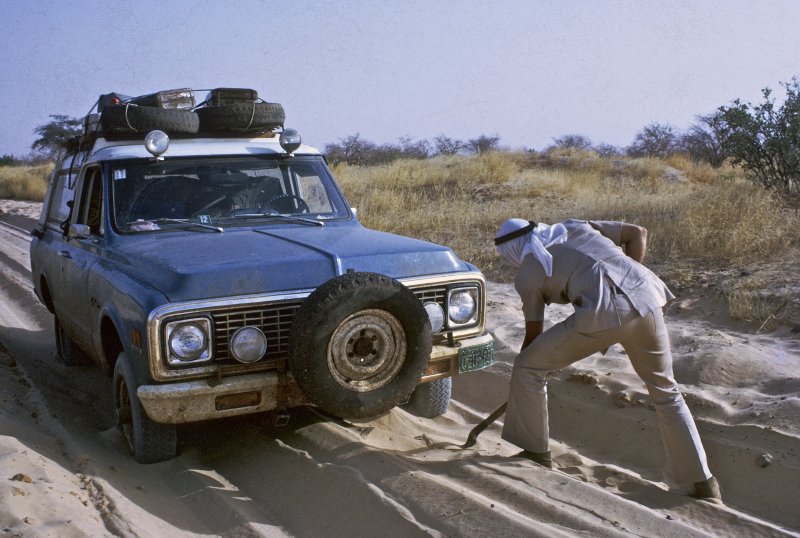I suppose that it is my turn. First incredible discussion!
What follows is my opinion and as such it is not worth the price of a cup of coffee, oh and there is No Math.
When I started exploring the PNW (US) in the 60’s as a kid we ran a then new International Travelall on them new radial tires, a 7.00Rx15 in a Michelin “Truck” Highway tires. Dad’s logic was that the manufacturer knew the best size tire… 200,000 miles when I sold that truck. I have come a long way since those skinny’s. After 30+years in various segments of the automotive field, predominantly the Off Road side, I have a grasp, and understanding of the Theoretical/Engineering reasoning. Fascinating stuff with friction in multi planes and both static and dynamic and slip angles, temperature, tread void ratios and stuff that I don’t fully understand…
In this conversation, a request was made for back to back experience, here is mine granted it has been a number of years ago. One of our past rigs, trail ready weighed 5800#US, give or take; V8 Powered, Manual Box, typical American “Truck based” SUV. We had the opportunity to run the same trail route of mixed terrain from deep mud to rocks on two sets of tires in about 8 hours. A set of 33-9.50 BFG MT and a set of the then new 35-12.50 BFG MT. Absolutely, the 9.50's I could not get off the truck fast enough! During the course of that day, there simply was not a single place where the skinny tire performed even adequately in comparison to the 12.50, including pavement! After that, I do not consider a 12.50 section on a 10” wide rim ‘portly’, it became simply “small” LOL!
Flip-side.
Today on our current rig (+4000#-empty) I chose the 33-10.50Rx15 BFG AT's on a lightweight OE alloy wheel for every reason listed in Scott's paper, however I did so because of the application, predominantly a Daily Driver(mileage), on pavement and biased to Snow and Ice on that pavement. When the weather gets real bad I’ll reach for the big truck on 37-12.50’s and fill the bed with sand AND chain all 4 wheels, but we are talking Feet of snow then.
It is not just the width that factors into the Ff, Cf, Fv; the diameter and tread void ratio plays a large part as well as the rubber compound and rim width. Further, it is as Scott notes, possible to exceed the Fv that a particular surface dynamic will tolerate. Due to surface irregularity/structural variability it is far easier then I feel is recognized once the tire leaves the tarmac. On the road down to a point that is load derived, I can agree with a thinner tire, never skinny thanks.
There is a dynamic that I have experienced with the tall skinny (yes I ran them back in the day) and that is rolling the sidewall. The Aspect Ratio coupled to the Rim Width are the primary determinants, and the taller the sidewall in relation to the width of the section can introduce a scenario where the tire will simply roll off the rim. That may likely never occur on the Rover or Jeep that had a top speed of 40-MPH (owned one of those) unless subject to a side hill that rates high on the pucker factor. However, because of the driver of our current rig will (has) sat at 90MPH for extended periods on pavement and covering ground in the desert the needle sees that same indicated speed exceeded though not for as extended of a time period; driving off the tire is a possibility, and avoidable by simply having some fat in the tire section.
It is interesting that the environmental realities of this conversation just came up. I can think of no terrain where the skinny tire causes less impact simply because of the greater unit loading that the smaller contact patch generates. This irrefutable dynamic being one of the “attributes” of the skinny tire. Anecdotal evidence on my part is simply the fact that I have both been stuck and pulled more vehicles out of “stucks” that were shod with Skinny tires then on wider tires. I dearly love the, “it will dig down to the solid stuff under the mud” argument. No not unless it is HUGE in diameter it wont! The only way you are going through that stuff with skinny tires is on the hook attached to a 15,000-SLP pound winch.
Simply based on my experience, which is valid only to myself, there is a functional limit to width on both sides. There is not a vehicle I can think of I would choose to run less then a 10.5” (250mm) section and I would not hesitate to run up to a 13” (325mm) section in a 36-38 inch OD.
Finally thanks for sharing the conversation here by the fire! However, I cannot see the fire anymore from here somebody moved it!:ylsmoke:
Agree or not on the aspect ratio, this has been fun!
Salute!


